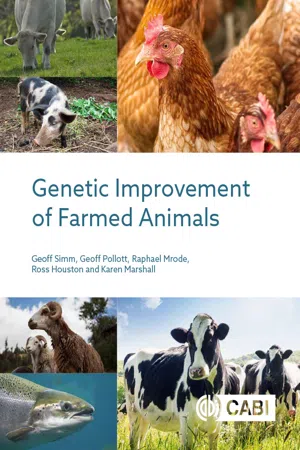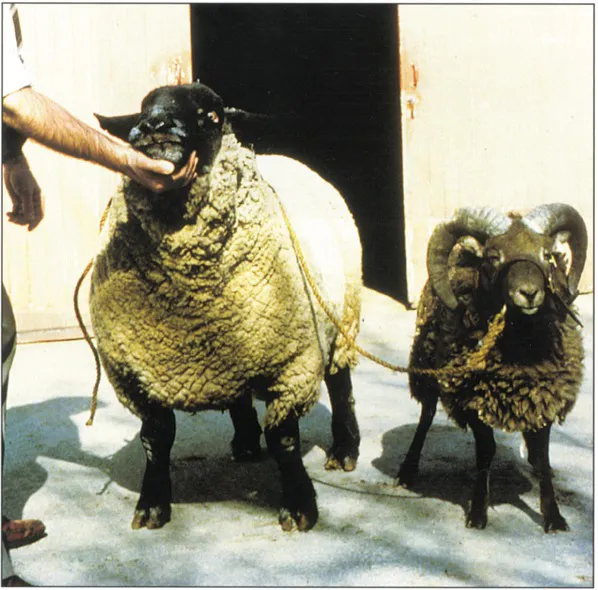![]()
1 The Origins and Rôles of Today’s Livestock Breeds
Natural Selection and Evolution
Animals come in an incredible variety of sizes, shapes and colours. Just why this is so has occupied many great minds over the centuries. Most biologists today believe that the species which we farm, keep as pets, observe in the wild or see on our screens, and those now extinct, evolved by the process of natural selection. Although several 19th century naturalists and philosophers contributed ideas, Charles Darwin is usually credited with putting together a cohesive theory of natural selection in 1838. He later explained this in his book On the Origin of Species – or On the Origin of Species by Means of Natural Selection, or the Preservation of Favoured Races in the Struggle for Life, to give it its full title – first published in 1859.
The main principles of Darwin's theory of natural selection are that species can change over time, and that their survival or ‘success’ depends on how well they ‘fit’ their environment – what one of Darwin's supporters, Thomas Huxley, described as ‘the survival of the fittest’. The key to this process is variation between individuals, in particular variation which is (at least partly) inherited from one generation to the next. Darwin recognized the ‘many slight differences which appear in the offspring from the same parents’ – it is these differences which natural selection, or breeders of domestic livestock, can act upon. Those individuals which have favourable attributes stand a higher chance of surviving and reproducing than those that do not.
This theory provides an explanation of how the huge variety of animal species, and other species, has arisen from the earliest primitive forms of life. Chance variations in the size or shape or functioning of animals, over the course of millions of years, has allowed them to adapt to particular environments, or niches. Some species have been able to adapt to and profit from major changes in the environment while others, such as the dinosaurs, have not and have become extinct. Many new species have emerged, usually as a result of physical isolation of part of a population – for example, when continents drifted apart – or due to isolation of other kinds, such as increasing dependence on a particular type of food. One of the most famous examples of natural selection comes from Darwin’s visit to the Galapagos Islands. There, he noticed the wide variety in the size and shape of the beaks of different species of finches, which was related to the way in which each species obtained its food. Although Darwin’s work is usually linked to evolution and natural selection of wild animals, he was well aware of, and greatly influenced by, the changes in domestic animals brought about by artificial selection in these species by early livestock breeders, as shown in his 1868 work The Variation of Animals and Plants Under Domestication (Darwin, 1868).
Darwin’s theory was highly controversial at the time, but there is now overwhelming evidence, from many branches of science, that it is substantially correct. For more details of the background to Darwin’s work, and developments from it, see Leakey (1986), Clutton-Brock (1987), Futuyma and Kirkpatrick (2017) and Walsh and Lynch (2018).
Domestication
Over the last 250,000 years, the human population has increased from an estimated 3 million to over 7.7 billion (Clutton-Brock, 1987; UN, 2019). During this time, the life expectancy of humans has also increased substantially. The increase in population size has occurred in four main surges. The first was stimulated when our early ancestors learned to use tools and make fire – attributes which allowed them to spread from the tropical regions in which they first evolved to inhabit colder, northern areas. The second surge (the first ‘agricultural revolution’) occurred about 12,000 to 10,000 years ago, when humans began to cultivate plants and domesticate animals after the end of the last ice age. The third surge in population size began with increased industrialization. For example, in Britain the population increased from about 5.5 million to about 10.75 million in the 18th century, with a particularly rapid rise in the second half of the century (Hall and Clutton-Brock, 1989). The fourth surge in population size followed the so-called ‘green revolution’ in the mid-1900s, which saw the introduction of new crop varieties, chemical fertilizers and pest controls. The world’s population is expected to approach 11.0 billion by the end of this century (UN, 2019). Feeding this growing population well, while protecting the natural systems on which we all depend, is one of the greatest challenges facing humanity – a topic we touch on throughout the book and return to in more detail in Chapter 14.
When humans first spread northwards, they were primarily hunters who adapted their own lifestyle to that of their prey (Clutton-Brock, 1987). Some groups, such as the Indigenous Peoples of North America following herds of bison, or Sámi people following reindeer, continued this lifestyle. Others learned to modify the behaviour of some of their prey species, and so began the process of domestication.
Of the very large number of animal species, very few have been successfully domesticated. Francis Galton (Darwin’s cousin) wrote an essay on domestication in 1865, and he suggested that the process of domestication happened by trial and error. He reasoned that ‘..a vast number of half-unconscious attempts have been made throughout the course of ages, and that ultimately, by slow degrees, after many relapses, and continued selection, our several domestic breeds became firmly established’. Galton also identified six conditions for successful domestication of a species of animals, including their ability to breed in captivity, to cope with earlier weaning than normal, to adapt to artificial feeding and husbandry, to be reasonably placid and amenable to being herded and closely confined, and to have products valuable to our ancestors (Clutton-Brock, 1987).
Sheep and goats were probably the first of our current farm livestock species to be domesticated, about 10,000 years ago, though domestication of the dog began about 2000 years earlier. They were followed by cattle and pigs, and later still by horses. The process continues today with domestication of new species used in aquaculture. Domestication has led to many differences from the wild ancestors – either as a direct result of domestication itself, by chance, by natural selection or, directly or indirectly, as a result of artificial selection. Usually, there is a much greater diversity in appearance of the domestic strains of livestock than in their wild counterparts. In many cases the domestic strains of terrestrial livestock differ from the wild type in physical appearance, including a shortening of the facial region of the skull and the jaws, longer ears, longer or curling tails, differences in the size or shape of horns, differences in coat or feather colour, and a wide range in the thickness of the coat, depending on the local climate (Clutton-Brock, 1987). Most domestic species have a higher concentration of fat in their carcass than their wild ancestors (Fig. 1.1). Also, most breeds of domestic sheep have lost the characteristic of completely shedding wool in the summer. (In some countries where the costs of shearing are high in relation to the value of the wool, there is renewed interest in this ability to shed wool naturally. See Chapter 10 for more details.)
Fig. 1.1. Domestication has brought about many changes in animals, including changes in size and fatness. This figure shows a Suffolk ram, a breed that has undergone many generations of selection for growth and meat production, compared to a Soay ram, a breed that has undergone very little artificial selection and retains many of the characteristics of its wild predecessors, including a leaner carcass than many ‘improved’ breeds. (Courtesy of Professor John Robinson.)
Modern livestock breeders are sometimes accused of producing maladapted breeds or individuals (see Chapters 8 to 13), but it is interesting to note that as long ago as 450 BC there were strains of fat-tailed sheep in Arabia with tails so long and fat that shepherds crafted small wooden trailers, harnessed to the sheep, to prevent their tails from dragging on the ground (Clutton-Brock, 1987).
The domestication of livestock species continues to be a well-researched topic with the inevitable appearance of conflicting theories. We do not intend to explore these in detail in this book, but there are several authoritative treatments of the subject. In the initial pages of their survey of the state of the world’s animal genetic resources the Food and Agriculture Organization (FAO) of the United Nations (UN) (2015a, pp. 5–23) outline much of the recent work on domestication of livestock species. Needless to say, the advent of molecular genomic methods has contributed to this debate and the paper by Magee et al. (2014) in a whole edition of Animal Frontiers devoted to domestication issues is a useful source of information. Also, Bruford et al. (2003) and Weiner and Wilkinson (2011) put domestication into a modern genetic context. The paper by Mignon-Grasteau et al. (2005) approaches domestication from a resource allocation perspective, whereas Driscoll et al. (2009) provide an evolutionary viewpoint of domestication.
Livestock Breeds and Their Origins
A breed of livestock is basically a recognized interbreeding group of animals of a given species. In most cases, animals which belong to the same breed are of fairly uniform appearance. This appearance is inherited, and usually distinguishes the breed concerned from other breeds. However, in other cases animals are considered to belong to the same breed by virtue of their geographical location, and there is quite wide variation in their appearance. Breeds have been created by ‘reproductive isolation’ – that is, the formation of separate groups of animals, where mating occurs within the groups but not usually between them. This is analogous to the way in which new species or sub-species of wild animals evolve, except that the reproductive isolation of wild animals often occurs due to geographical dispersion, whereas reproductive isolation of domestic breeds is usually imposed by humans.
The UK Farm Animal Genetic Resources Committee define a breed as: ‘…an interbreeding population of husbanded or formerly husbanded domesticated animals of consistent genotype and phenotype with a recognized history and administrative framework’ (Defra, 2012).
The FAO (2007) def...

